We live our lives in “autopilot mode” much of the time. Is your autopilot set to get you where you want to go?
Did you create any New Year’s Resolutions at the beginning of this year? If so, how’s that going for you? If you’ve been moving forward with your resolutions, congratulations on intentionally changing some habits and behaviors!
If you find that change is hard and you are not moving forward as you’d like to, keep reading for tips to help.
Knowing vs. Doing
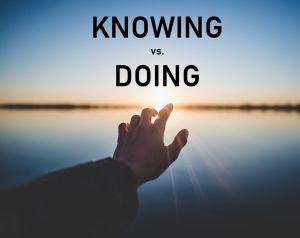 Knowing what to do and doing it as an automatic behavior are two very different things.
Knowing what to do and doing it as an automatic behavior are two very different things.
We attend self-help seminars and read all the how-to books offering great ideas. Unfortunately, it’s not what we know, but rather how we consistently apply that knowledge to our day-to-day lives that makes a difference.
So how do we bridge the gap between what we know and what we do?
Desired behavior doesn’t spontaneously occur by itself, and there are no quick fixes. We can temporarily change behavior with willpower, but only for a very limited time. After that, autopilot kicks in and we fall back into old behaviors and patterns, even when those habits do not serve us well.
We are creatures of habit. Taking the path of least resistance is easier, and most humans resist change.
Conscious Choice
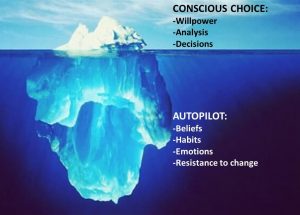 Humans are motivated to change behavior if that change will increase pleasure or decrease pain in their lives. You are much less likely to change unless the discomfort you feel during the process of change is less painful than if you keep things as they are right now.
Humans are motivated to change behavior if that change will increase pleasure or decrease pain in their lives. You are much less likely to change unless the discomfort you feel during the process of change is less painful than if you keep things as they are right now.
Conscious choice is key to your success as you go through the steps required to get from where you are to where you want to be.
Are you living your life on purpose? Or is your self-talk full of “I should…” or “I have to…” or “I can’t…”? How often do you say “I choose to…”?
“You are free to choose, but the choices you make today will determine what you will have, be, and do in the tomorrow of your life.” — Zig Ziglar
Would you get on an airplane with a pilot who didn’t create and follow a flight plan? Although most of the time pilots are not perfectly on course — they veer slightly off to the left or the right — they consistently make course corrections so they reach their ultimate destination.
We can have a plan, even if we don’t stick with it 100% of the time. But if we don’t have a plan, we may veer off course and never have an ultimate destination to come back to.
“If you don’t know where you’re going, any road will get you there.”
-Lewis Carroll, Alice’s Adventures in Wonderland
Do your existing habits serve you well? If not, which habits will you consciously change so you can create the “course correction” you desire?
Four Behavioral Stages of Changing Habits
Research has shown that the unconscious part of our brains are very uncomfortable with the unfamiliar. Our brains naturally move through four behavioral stages as we form new habits:
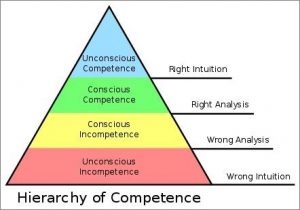
- Unconscious incompetence: “I don’t even know that I don’t know what I don’t know.” Intuition does not exist.
- Conscious incompetence: “I now know where I ought to be and what I ought to be doing, but I don’t know how to get myself there, or how to get myself to do it.” This is the analysis stage people often find themselves in after attending a great workshop or reading a good book.
- Conscious competence: “I now know how to make it happen, and I know I can do it, but I have to keep reminding myself to do it, as it does not come naturally to me.” This analysis stage is sometimes full of fear and doubt. You’ve come this far, but you can’t seem to consistently maintain the new habit.
- Unconscious competence: “I just do it. I only think about it when I don’t do it, and then I have to go do it.” You are in autopilot and are driven by your intuition. This is like brushing your teeth before bed. You don’t have to concentrate to remember to do it.
The unconscious competence level is the ultimate aim. This is where the new habit is so ingrained into your nervous systems that you can’t stand the discomfort of not doing it.
Because your automatic response system in your brain has a natural aversion to change, the support of a non-judgmental third party provides essential support and structure as you move through the process of creating consistent and lasting behaviors that get you wherever you want to go.
Overcome Fear and Get Focused
There are two main obstacles that hold people back from getting what they really want from their personal and professional lives – fear and lack of consistent focus.
Use this acronym to help you remember these four steps to overcoming F.E.A.R.:
- FOCUS: What’s most important to you? What does the end result look like? What steps are required to get you there?
- EXPLORE: What are you resisting? What warning signals are present when you resist? What’s the ultimate fear behind these warning signals? What’s the worst thing that could happen? Even if the worst thing did happen, could you live with it?
 ASSESS: What are your options? What action do you choose to take? What’s next for you? What support could you get to help you?
ASSESS: What are your options? What action do you choose to take? What’s next for you? What support could you get to help you?
- RESPOND: This is where the rubber meets the road – where you choose to consistently say “yes” to the action you have chosen for yourself. If you are not ready to act, repeat this process until you are ready to move forward.
Susan Jeffers has written a book, Feel the Fear and Do It Anyway, which shows readers how to get what they want in spite of their self-sabotaging fears, turning passivity into assertiveness. The book offers suggestions about how to risk a little every day, how to turn every decision into a “no-lose” situation, and how to stop negative thinking patterns that say “I can’t” and begin thinking more positively.
Narrow Your Focus to Three Intentions at a Time
 Because your brain can only focus on so much at one time, I suggest that you identify no more than three habits to work on over the next 90 days. Jot down your three most important areas of focus, and then write a description of the measurable results (goals) you intend to achieve under each.
Because your brain can only focus on so much at one time, I suggest that you identify no more than three habits to work on over the next 90 days. Jot down your three most important areas of focus, and then write a description of the measurable results (goals) you intend to achieve under each.
I’ll provide an EXAMPLE below of how this might look:
- Be more productive at work.
- Put a reminder system in place to follow up on calls and letters in a timely way.
- Be on time or early for appointments.
- Take printed materials with me so I can catch up on my reading if I’m early for an appointment.
- Break larger tasks into smaller ones with deadlines assigned to each smaller task. Schedule these tasks into my calendar.
- Set realistic goals and deadlines for new projects and stay on task.
- Remind myself that when I say “yes” to one thing I am saying “no” to other things. Only say yes to what’s important to me.
- Do weekly planning every Friday afternoon for the coming week.
- Improve my health and fitness.
- Design and follow a workout program that will reduce my body fat to 20% by September 1.
- Do 30 minutes of interval cardio workout 3x/week while maintaining my target heart range.
- Pack my lunch and only go out to eat for appointments with others.
- Choose low-carb options when I go out to eat.
- Eat smaller portions. Wait 20 minutes before taking seconds or finishing what’s on my plate when at a restaurant.
- Eat 3 meals a day; finish the last meal before 8 PM.
- Minimize sugar and starchy carb consumption.
- Take daily vitamin supplements.
- Create more romance with my spouse.
- Plan a “date night” each week and arrange a babysitter for the kids.
- Plan a quarterly weekend overnight away and arrange for the kids to have an overnight with the grandparents.
- Bring home thoughtful surprise gifts that express my gratitude for all that my partner does for the kids and me.
- Give daily compliments and acknowledgments for who my partner is being.
Remember…trying to consistently concentrate on honoring more than three intentions at a time can put your mind into overload.
Sometimes we need a sounding board to reflect back to us what we’re saying so we can hear ourselves. Consider teaming up with someone who can be that sounding board for you. A coach or a trusted friend can help you listen to your self-talk and reflect on your self-defeating habits, while also holding you accountable for taking the intended action you’ve identified.
As a coach, I can offer insights and non-judgmental support to help you create new autopilot modes — not just for the next few days, but for a lifetime. If you’d like a fresh perspective– someone to help you design the life you want by aligning your vision, priorities, and actions—let’s schedule a no-cost, no-pressure Discovery Call today.
Additional Resources
- Blog: What Are You Committed To for 2019?
- Blog: March Forth
- Blog: What Mindset Rules Your Life?
- Blog: 9 Reasons People Abandon Their New Year’s Resolutions
- Blog: Keep Going!
- Blog: Is Fear Running Your Life?
- Free webinar: Managing Priorities
- Free webinar: Buried in Paper
- Guide: Creating New Habits
- Guide: 12 Daily Habits to Improve Your Health & Well-being
- Guide: Cultivating Happiness: Living Life on Your Terms
- Guide: Living with Purpose


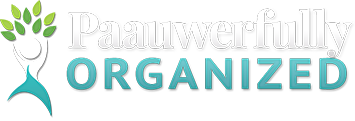




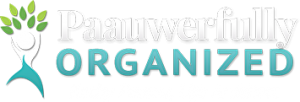


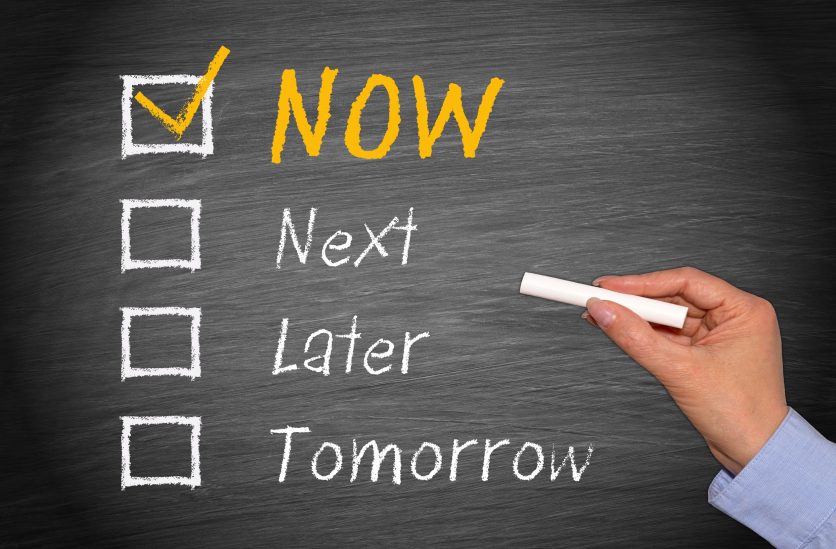
Kathy you are always on target and give such valuable information. Thank you Bonnie
Thank you, Bonnie!